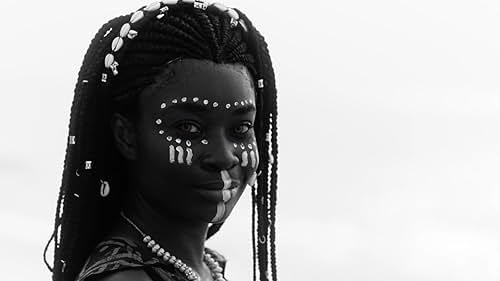
Mami Wata
“Mami Wata” is a fable mixed with a thriller from Benin, shot in black and white and set in a seaside village called Iwi. It opens on the ocean at night. the crashing surf is blurred almost to abstraction; the water occupies only the bottom of the frame, everything else is darkness. Mood, then wonder and dread writer/director C.J. “Fiery” Obasi creates these things by holding onto an image longer than most movies would.
Throughout its running time, it does this shows an image or situation not quite as you expect and stays with that for more or less time than you expect. The rhythm is unbalancing; you feel detached from whatever preconceptions you carried in. The film casts a spell, and the spell remains until it’s over.
“Mami Wata” is filled with people who dress and act like they’re from another century, resisting the modern world. It’s a matriarchy. Mama Efe (Rita Edochie) is the anointed priestess and interpreter of Mami Wata, as well as the arbiter and problem-solver for everyone in town.
But Mama Efe is powerful and respected, and some of her people are starting to feel that she’s losing her connection to the goddess, or that she’s too set in her ways to see that the village can only survive if it adapts to modern life. Mama Efe has two children: her biological daughter Zinwe (Uzoamaka Aniunoh) and her adoptive daughter Prisca (Evelyne Ily Juhen).
Prisca is almost completely estranged from Mama Efe partly because she shares the feelings of dissatisfied fellow villagers but there’s a personal component as well, one that transcends culture and will be understandable to anyone who fears that blood trumps every other bond. Zinwe is more loyal, but she’s got her own doubts. She wants to be reassured that the old ways are right, that the magic is strong, and that she will inherit all.
But her mother’s not what she used to be.
The catalyzing event early in “Mami Wata” comes when a sick young boy dies. The ritual fails. Incantations are said; potions are concocted, nothing works. The citizens demand answers to questions they once discussed only in private: Why doesn’t this village have a doctor? Or a police force? Or a fire station? Or electricity? Rebellion could break out here at any moment under certain conditions.
And then one day a man washes up on the beach as if fulfilling a prophecy or curse. His name is Jasper (Emeka Amakeze). He’s got the look of a classic Hollywood movie star. Or a classic Nigerian movie star. Or both. He exudes confidence, power and the insinuating, dangerous magnetism that made old school Hollywood “rebel” actors like Marlon Brando and Paul Newman so popular. And once Jasper enters the picture, “Mami Wata” becomes more of a political fable with elements of art house film noir and crime thrillers that didn’t have much of a budget but made up for it with swaggering minimalism.
The framing, blocking and lighting of the shots (by cinematographer Lílis Soares, who won an award for this film at this year’s Sundance Film Festival) amount to a bridge between past and present that the characters yearn for but cannot manifest.
You can’t pick apart “Mami Wata” in terms of plausibility or real-world details. It’s not interested in those things. It’s a dream with its own internal logic and consistency. A person, location or object always has a specific plot function but is imbued with other meanings and inspires varied interpretations.
The movie doesn’t explain itself. It doesn’t need to. It’s all there, in the images and performances and sounds. The dialogue is in pidgin English, with subtitles, but I’m pretty sure there are times when you’ll forget to read them, you know what these characters want; you feel what they feel, you see through their eyes.
Before he started shooting, Obasi said he wanted to create a film that felt like it was made in another world. And that’s exactly what he and his collaborators did. They have made something in the vein of David Lynch, Jane Campion (specifically “The Piano” and “Power of the Dog”), Alejandro Jodorowsky (“El Topo”), Jim Jarmusch (“Dead Man”) and Yasujirō Ozu (in the framing of some the dialogue scenes in “Tokyo Story”).
But this movie has its own life force, its own confidence If you’re on its frequency, you won’t be wondering what happens next, you’ll be with whatever is happening at that moment. Whether that’s men and women flirting and dancing in a local bar, the village writhing in anguish, or the sisters bickering on a beach at night, their faces and bodies etched by white light that seems to be what it looks like when modern eyes have re-acclimated to nature when you only need moonlight to see.
For More Movies Visit Putlocker.